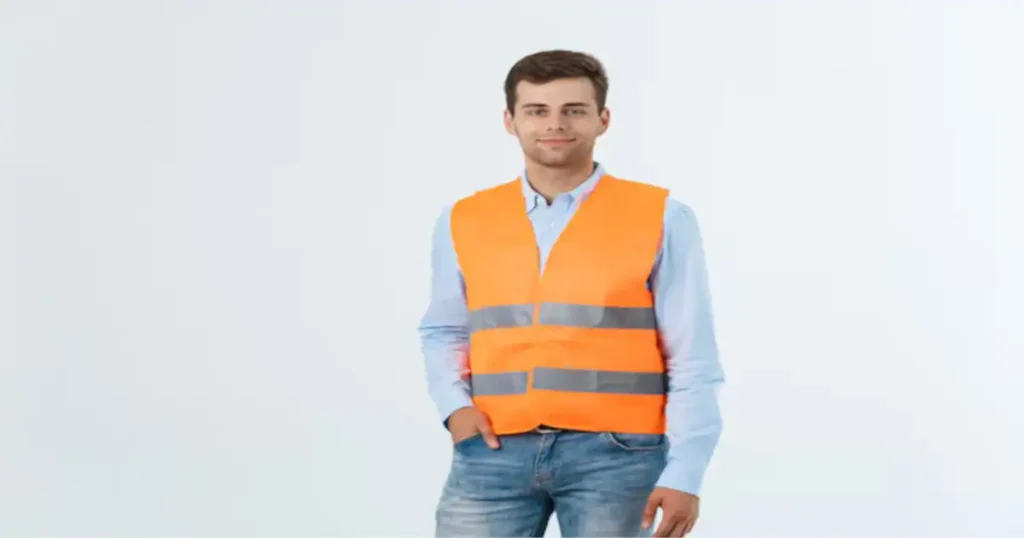Table of Contents
ToggleIntroduction to work vest
1. Understanding the Purpose of a Work Vest
A work vest is more than just an additional layer of clothing; it is designed to provide visibility, safety, and functionality to workers in various sectors. Work vests typically serve three main purposes:
- Visibility: High-visibility vests make workers stand out, reducing the risk of accidents.
- Protection: Certain work vests offer protection against impacts, fire, and chemical spills.
- Utility: Many work vests come with multiple pockets and compartments, allowing workers to carry tools and essentials hands-free.
From construction sites to roadwork zones, work vests are a staple in industries where safety and convenience are paramount.
2. Types of Work Vests
There are several types of work vests, each designed to meet specific needs. Below are some of the most common ones:
a. High-Visibility Vests
High-visibility (hi-vis) vests are essential for workers who need to be seen from a distance. These vests come in fluorescent colors like neon yellow, green, and orange, often with reflective strips that increase visibility in low-light conditions. Hi-vis vests are common in construction, roadwork, and traffic management.
b. Safety Vests
Safety vests are designed to protect workers in hazardous environments. These vests may include features like fire resistance, cut resistance, or even bulletproof materials for those in high-risk jobs like security and law enforcement.
c. Utility Vests
Utility vests are equipped with multiple pockets, pouches, and loops to carry tools and accessories. This type is commonly worn by mechanics, electricians, and field technicians who require easy access to their tools.
d. Cooling and Heating Vests
Some work environments require temperature control, and that’s where cooling and heating vests come in. Cooling vests are made with materials that retain cold, providing relief in hot weather. Heating vests, often battery-operated, help workers stay warm in cold environments.
e. Life Vests
For those working in or near water, life vests are crucial. These vests provide buoyancy and help prevent drowning. Life vests are mandatory for workers in maritime, fishing, and offshore drilling industries.
f. Tactical Vests
Primarily used by law enforcement and military personnel, tactical vests offer protection against impacts and can carry a wide array of gear, from ammunition to radios. They are often made of durable materials and include MOLLE (Modular Lightweight Load-carrying Equipment) systems.
3. Key Features of Quality Work Vests
The best work vests are built to withstand tough environments and provide comfort and utility to the wearer. Here are some features to look for:
- Reflective Strips: Reflective strips ensure the vest is visible in low-light or nighttime settings.
- Pockets and Compartments: The more organized storage, the better for carrying tools and essentials.
- Adjustability: Adjustable straps or sides allow for a snug and secure fit.
- Durability: Made of high-quality materials, a durable vest should withstand daily wear and tear.
- Weather Resistance: A waterproof or weather-resistant vest can be crucial for those working in unpredictable weather conditions.
- Breathability: Look for breathable fabrics, especially if working in hot or physically demanding environments.
4. Materials Used in Work Vests
Choosing the right material is essential as it impacts the vest’s comfort, durability, and functionality. Some popular materials include:
- Polyester: Known for its durability and resistance to shrinkage, polyester is often used for hi-vis vests.
- Mesh: Mesh fabric provides ventilation and is a common choice for vests meant for warm environments.
- Cotton: Cotton is comfortable and breathable, ideal for everyday wear in non-hazardous environments.
- Nylon: Nylon is strong, durable, and often used in tactical and utility vests.
- Kevlar: For vests that require protection against cuts or bullets, Kevlar is a preferred material due to its high tensile strength.
5. Safety Standards and Regulations
Work vests often need to meet specific safety standards, depending on the industry. For example:
- ANSI/ISEA Standards: The American National Standards Institute (ANSI) and the International Safety Equipment Association (ISEA) have set standards for high-visibility garments, including work vests. ANSI classifies hi-vis vests into three classes based on the level of visibility they provide.
- NFPA Standards: The National Fire Protection Association (NFPA) sets standards for flame-resistant clothing, including some safety vests.
- EN ISO Standards: In Europe, the EN ISO standards govern protective workwear, including requirements for hi-vis and life vests.
Adhering to these standards ensures that the vest provides the level of protection needed for specific job requirements.
6. How to Choose the Right Work Vest
Selecting the right work vest involves considering the following factors:
- Job Requirements: Determine whether you need visibility, protection, or utility features based on your job.
- Comfort and Fit: A vest should fit comfortably without restricting movement.
- Weather Conditions: For outdoor work, consider a vest that offers weather protection.
- Budget: While safety is priceless, finding a vest within your budget that meets your needs is important.
- Certifications and Standards: Always check if the vest meets the necessary safety standards for your industry.
7. Benefits of Wearing a Work Vest
The benefits of wearing a work vest go beyond just safety:
- Enhanced Safety: Hi-vis and protective vests reduce the risk of accidents and injuries.
- Increased Efficiency: Utility vests allow workers to carry tools, increasing productivity.
- Temperature Control: Cooling and heating vests improve comfort in extreme temperatures.
- Professionalism: Wearing a vest can enhance your professional appearance, especially in fields like security and construction.
8. Top Brands for Work Vests
When it comes to work vests, choosing a reliable brand can make a world of difference in terms of durability, comfort, and safety features. Here are some of the most trusted brands that provide high-quality work vests for a variety of industries:
- Carhartt: Known for its rugged designs and commitment to durability, Carhartt is a go-to brand for those who need sturdy, long-lasting workwear. Carhartt’s vests are built to endure tough conditions and are particularly popular in construction and industrial work due to their reinforced seams, comfortable fit, and practical features.
- 3M: A leader in high-visibility and safety clothing, 3M is highly regarded for its range of reflective and protective vests. Their work vests incorporate advanced reflective materials that enhance visibility in low-light conditions, making them ideal for roadside, construction, and other high-risk environments where visibility is critical.
- Pyramex: Pyramex offers a line of affordable yet functional safety vests without compromising on quality. Known for lightweight, comfortable designs, Pyramex vests are perfect for workers who need a balance of visibility, comfort, and practicality. The brand is especially popular in sectors where budget-friendly safety gear is essential.
- Blauer: Blauer specializes in tactical and law enforcement vests, providing robust designs that meet the high demands of police, military, and security personnel. Blauer vests are crafted with a focus on mobility, durability, and protection, often including MOLLE systems and additional storage for essential gear.
- ML Kishigo: A top choice in the world of high-visibility vests, ML Kishigo combines innovative reflective technology with durable materials, creating vests that excel in both visibility and longevity. Kishigo vests are often chosen by professionals working in road safety, utility, and other high-visibility-required fields, offering reflective striping and color options that meet strict safety standards.
- Helly Hansen: Known for their quality outdoor and industrial wear, Helly Hansen produces work vests designed to withstand harsh environments. Their vests offer both insulation for cold weather and breathability for warmer conditions, making them ideal for diverse job sites. Helly Hansen combines performance with comfort, appealing to those who work in varied climates.
- Radians: Radians is a trusted brand for PPE and high-visibility vests, known for their wide selection of ANSI-compliant safety gear. Radians vests are designed with functional features like multiple pockets, tear-away options, and adjustable fits, making them suitable for construction, utility work, and other high-activity jobs.
9. Maintenance and Care Tips
Proper maintenance extends the life of your work vest. Here are some tips:
- Regular Washing: Follow the manufacturer’s instructions for washing to maintain reflectivity and fabric quality.
- Inspect for Wear and Tear: Regularly check for frays, tears, or faded reflective strips and replace the vest if necessary.
- Storage: Store vests in a cool, dry place away from direct sunlight to prevent material degradation.
Conclusion
Investing in a high-quality work vest is a smart decision that goes beyond just adding a layer to your workwear—it’s about prioritizing safety, enhancing comfort, and boosting productivity on the job. With the wide variety of work vests available today, selecting the right one can feel overwhelming. However, by focusing on key factors such as material durability, visibility features, compliance with safety standards, and the specific functionality you need, you can make an informed choice that meets the demands of your role.
Whether you’re working in construction, emergency response, or any environment where safety is critical, a well-chosen work vest can significantly reduce risks and help you perform your tasks more efficiently. Remember, a work vest isn’t just a uniform—it’s a reliable companion that keeps you visible, protected, and organized. Take the time to choose a vest that aligns with your job’s specific requirements, and you’ll have a piece of gear that serves you well day in and day out.
Your safety and peace of mind are invaluable. Equip yourself with the right work vest, and you’ll not only protect yourself but also ensure you’re prepared for the demands and unpredictability of any work environment.
Frequently Asked Questions (FAQs)
What is the main purpose of a work vest?
A work vest is primarily designed to improve worker safety, visibility, and convenience. By providing high-visibility colors, protective materials, and extra storage for tools, work vests support those in industries like construction, emergency response, and security, helping them stay protected and efficient on the job.
How do I choose the right work vest for my job?
Selecting the right work vest depends on your job’s specific demands. Consider the required level of visibility, protection, and tool storage. If you work outdoors, look for weather-resistant vests. Always check for industry standards, like ANSI or NFPA, to ensure the vest meets safety requirements for your field.
Are cooling vests and heating vests effective in extreme temperatures?
Yes, both cooling and heating vests are effective in regulating body temperature in extreme weather. Cooling vests help reduce heat exposure by retaining a cooler temperature, while heating vests, often battery-operated, provide warmth for those working in cold environments.
How often should I replace my work vest?
Replace your work vest as soon as you notice signs of wear, such as tears, frayed edges, or faded reflective strips, which can reduce visibility and protection. Regular inspections can help determine if the vest is still in optimal condition or needs replacement.
Can I wash my high-visibility work vest?
Yes, most high-visibility vests are washable, but always follow the manufacturer’s instructions to preserve the reflective material and colors. Improper washing can damage the fabric and reduce the vest’s effectiveness, especially its visibility in low-light settings.
Do all work vests need to meet specific safety standards?
Not all work vests have mandatory safety standards, but those used in high-risk or high-visibility settings typically must comply with regulations like ANSI or NFPA. Checking for compliance ensures that the vest offers the necessary safety and protection for specific jobs or environments.
READ ALSO: Unlock Success: CFMEU RDO Calendar 2024 QLD – 7 Essential Dates You Can’t Afford to Miss





















